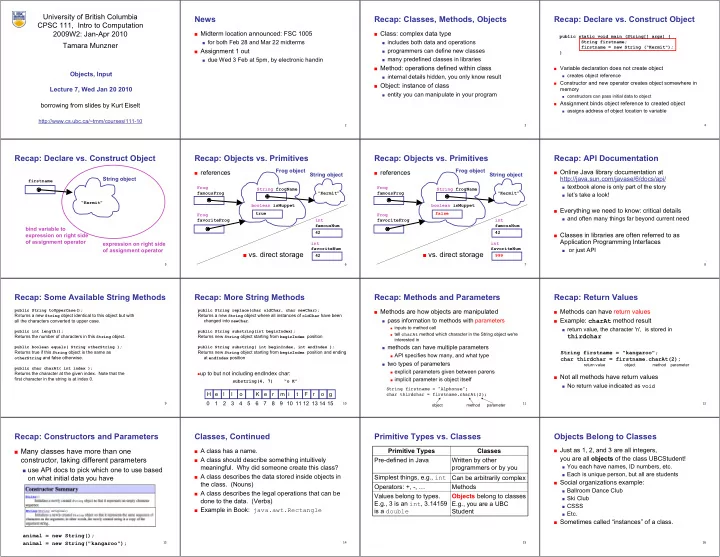

University of British Columbia News Recap: Classes, Methods, Objects Recap: Declare vs. Construct Object CPSC 111, Intro to Computation 2009W2: Jan-Apr 2010 ■ Midterm location announced: FSC 1005 ■ Class: complex data type public static void main (String[] args) { ■ for both Feb 28 and Mar 22 midterms ■ includes both data and operations String firstname; Tamara Munzner firstname = new String (“Kermit"); ■ Assignment 1 out ■ programmers can define new classes } ■ many predefined classes in libraries ■ due Wed 3 Feb at 5pm, by electronic handin ■ Method: operations defined within class ■ Variable declaration does not create object Objects, Input ■ internal details hidden, you only know result ■ creates object reference ■ Constructor and new operator creates object somewhere in ■ Object: instance of class Lecture 7, Wed Jan 20 2010 memory ■ entity you can manipulate in your program ■ constructors can pass initial data to object ■ Assignment binds object reference to created object borrowing from slides by Kurt Eiselt ■ assigns address of object location to variable http://www.cs.ubc.ca/~tmm/courses/111-10 1 2 3 4 Recap: Declare vs. Construct Object Recap: Objects vs. Primitives Recap: Objects vs. Primitives Recap: API Documentation Frog object Frog object ■ references ■ references ■ Online Java library documentation at String object String object http://java.sun.com/javase/6/docs/api/ String object firstname ■ textbook alone is only part of the story Frog Frog String frogName String frogName famousFrog “Kermit” famousFrog “Kermit” ■ let’s take a look! “Kermit” boolean isMuppet boolean isMuppet ■ Everything we need to know: critical details true false Frog Frog ■ and often many things far beyond current need favoriteFrog int favoriteFrog int famousNum famousNum bind variable to 42 42 ■ Classes in libraries are often referred to as expression on right side of assignment operator Application Programming Interfaces expression on right side int int favoriteNum favoriteNum ■ or just API of assignment operator ■ vs. direct storage ■ vs. direct storage 42 999 5 6 7 8 Recap: Some Available String Methods Recap: More String Methods Recap: Methods and Parameters Recap: Return Values public String toUpperCase(); public String replace(char oldChar, char newChar); ■ Methods are how objects are manipulated ■ Methods can have return values Returns a new String object identical to this object but with Returns a new String object where all instances of oldChar have been ■ pass information to methods with parameters ■ Example: charAt method result all the characters converted to upper case. changed into newChar . ■ inputs to method call ■ return value, the character 'n', is stored in public int length(); public String substring(int beginIndex); ■ tell charAt method which character in the String object we're thirdchar Returns the number of characters in this String object. Returns new String object starting from beginIndex position interested in ■ methods can have multiple parameters public boolean equals( String otherString ); public String substring( int beginIndex, int endIndex ); Returns true if this String object is the same as Returns new String object starting from beginIndex position and ending String firstname = "kangaroo"; ■ API specifies how many, and what type otherString and false otherwise. at endIndex position char thirdchar = firstname.charAt(2); ■ two types of parameters return value object method parameter public char charAt( int index ); ■ explicit parameters given between parens up to but not including endIndex char: Returns the character at the given index. Note that the ■ Not all methods have return values first character in the string is at index 0. ■ implicit parameter is object itself substring(4, 7) “o K” ■ No return value indicated as void String firstname = "Alphonse"; H e l l o K e r m i t F r o g char thirdchar = firstname.charAt(2); 0 1 2 3 4 5 6 7 8 9 10 11 12 13 14 15 9 10 11 12 object method parameter Recap: Constructors and Parameters Classes, Continued Primitive Types vs. Classes Objects Belong to Classes ■ Many classes have more than one ■ A class has a name. Primitive Types Classes ■ Just as 1, 2, and 3 are all integers, you are all objects of the class UBCStudent! constructor, taking different parameters ■ A class should describe something intuitively Pre-defined in Java Written by other ■ You each have names, ID numbers, etc. meaningful. Why did someone create this class? programmers or by you ■ use API docs to pick which one to use based ■ Each is unique person, but all are students ■ A class describes the data stored inside objects in on what initial data you have Simplest things, e.g., int Can be arbitrarily complex ■ Social organizations example: the class. (Nouns) Operators: +, -, … Methods ■ Ballroom Dance Club ■ A class describes the legal operations that can be Values belong to types. Objects belong to classes ■ Ski Club done to the data. (Verbs) E.g., 3 is an int , 3.14159 E.g., you are a UBC ■ CSSS ■ Example in Book: java.awt.Rectangle is a double Student ■ Etc. ■ Sometimes called “instances” of a class. animal = new String(); animal = new String("kangaroo"); 13 14 15 16
Recommend
More recommend